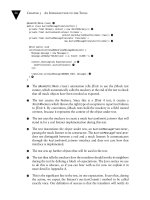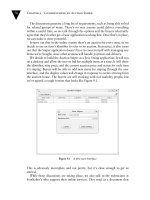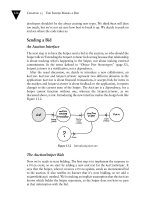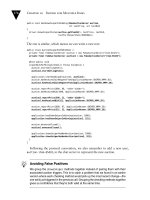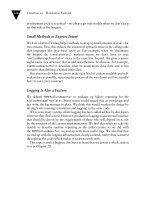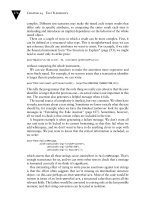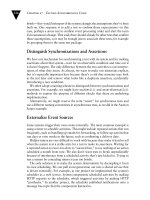Prentice object oriented software engineering using UML patterns and java 3rd 2012
Bạn đang xem bản rút gọn của tài liệu. Xem và tải ngay bản đầy đủ của tài liệu tại đây (4.57 MB, 817 trang )
Object-Oriented Software Engineering
Using UML, Patterns, and Java™
Third Edition
Bernd Bruegge & Allen H. Dutoit
Technical University of Munich
Department of Computer Science
Munich, Germany
Carnegie Mellon University
School of Computer Science
Pittsburgh, PA, United States
Prentice Hall
Boston Columbus Indianapolis New York San Francisco Upper Saddle River
Amsterdam Cape Town Dubai London Madrid Milan Munich Paris Montreal Toronto
Delhi Mexico City Sao Paulo Sydney Hong Kong Seoul Singapore Taipei Tokyo
Vice President and Editorial Director, ECS:
Marcia J. Horton
Editor in Chief: Michael Hirsch
Executive Editor: Tracy Dunkelberger
Assistant Editor: Melinda Haggerty
Editorial Assistant: Allison Michael
Director of Marketing: Margaret Waples
Marketing Manager: Erin Davis
Marketing Coordinator: Kathryn Ferranti
Senior Managing Editor: Scott Disanno
Senior Operations Supervisor: Alan Fischer
Operations Specialist: Lisa McDowell
Art Director: Kenny Beck
Cover Designer: Bruce Kenselaar
Media Editor: Dan Sandin
Copyright © 2010, 2004, 2000 Pearson Education, Inc., publishing as Prentice Hall. All rights
reserved. Manufactured in the United States of America. This publication is protected by
Copyright, and permission should be obtained from the publisher prior to any prohibited
reproduction, storage in a retrieval system, or transmission in any form or by any means,
electronic, mechanical, photocopying, recording, or likewise. To obtain permission(s) to use
material from this work, please submit a written request to Pearson Education, Inc.,
Permissions Department, One Lake Street, Upper Saddle River, NJ, 07458.
Many of the designations by manufacturers and seller to distinguish their products are claimed
as trademarks. Where those designations appear in this book, and the publisher was aware of a
trademark claim, the designations have been printed in initial caps or all caps.
Quote of Chapter 1 from Object-Oriented Analysis and Design with Applications by Booch,
© 1994 Benjamin Cummings Publishing Company Inc. Reprinted by permission of Pearson
Education, Inc.
Quotes of Chapters 2 & 12 from Zen and the Art of Motorcycle Maintenance by Robert Pirsig,
© 1974 by Robert Pirsig. Reprinted by permission of HarperCollins Publishers Inc. William
Morrow. For British Commonwealth excluding Canada, Zen and the Art of Motorcycle
Maintenance by Robert M. Pirsig published by Bodley Head. Used by persmission of The
Random House Group Limited.
Quote of Chapter 6 from The Emperor’s Old Clothes by C. A. R. Hoare, © 1981 Association
for Computing Machinery, Inc. Reprinted by permission.
Quote of Chapter 13 from Chapterhouse: Dune by Frank Herbert, © 1985 by Frank Herbert.
Used by permission of Berkeley Publishing Group, a division of Penguin Group (USA) Inc.
All other chapter quotes are in the public domain or fall within the realm of fair use.
Book photos: Bernd Bruegge, Rich Korf, and Blake Ward
Library of Congress Cataloging-in-Publication Data on File
10 9 8 7 6 5 4 3 2 1
Prentice Hall
is an imprint of
www.pearsonhighered.com
ISBN 10: 0-13-606125-7
ISBN 13: 978-0-13-606125-0
To Goeg, Toby, and Clara.
—B.B.
To my family:
Vicky, Eleni, Anna-Maria, Michelle, and Chris
with love.
—A.H.D.
This page intentionally left blank
Foreword
O
ver ten years ago, I read about a software engineering course taught by Bernd Bruegge at
Carnegie-Mellon University. In software engineering courses at many other universities, small
groups of 3 or 4 students were assigned several toy problems during a semester with deadlines of
less than a month. On such small projects, one strong programmer can carry the whole team by
brute force. It isn’t necessary to learn communication skills, use modeling tools, or deal with the
ambiguities of actual problems. Students come away unprepared for the complexities of realworld development. In Bruegge’s course, the entire class worked on a single, semester-long
project to produce a query-oriented navigation system for the city of Pittsburgh. They had to
build on the interactive mapping system produced by the previous semester’s class. The clients
were managers for the county planning department and port authority. The geographic and bus
schedule data had misspellings, inaccuracies, and incompatible formats. The students produced
an accepted system of over 27,000 lines of code. What a difference from the toy projects taught
at many other places! Students came away from the course with an appreciation of the need for
strategy, organization, and tools to deal with the complexity and messiness of the real world.
They learned software engineering the only way one learns any craft—by practicing it on
realistic cases.
This book is a reflection of that pragmatic philosophy of software development as an
engineering discipline. The authors adopt a point of view—an object-oriented approach using
UML—that makes the many facets of software engineering approachable to students. They
cover both the modeling techniques and the human communications skills needed to achieve
success. They also include several chapters on managing change, a topic that appears in every
real project but which is often neglected in texts. Readers of this book will gain a solid
appreciation of the rich scope and complexity of software engineering.
v
vi
Foreword
I particularly enjoyed the many illuminating anecdotes selected from a wide range of
fields. These provide lively examples of problems large and small that illustrate the subtleties
and traps that engineers must confront. Any book that makes relevant examples of Polynesian
navigation, the tangled history of the text of Tolkien’s Lord of the Rings, and grandmother’s
recipe for trimming hams is not only useful but also fun to read.
Jim Rumbaugh
Preface
T
he K2 towers at 8,611 meters in the Karakorum range of the western Himalayas. It is the
second highest peak of the world and is considered the most difficult 8000er to climb. An
expedition to the K2 typically lasts several months in the summer, when the weather is most
favorable. Even in summer, snowstorms are frequent. An expedition requires thousands of
pounds of equipment, including climbing gear, severe weather protection gear, tents, food,
communication equipment, and pay and shoes for hundreds of porters. Planning such an
expedition takes a significant amount of time in the life of a climber and requires dozens of
participants in supporting roles. Once on site, many unexpected events, such as avalanches,
porter strikes, or equipment failures, will force the climbers to adapt, find new solutions, or
retreat. The success rate for expeditions to the K2 is currently less than 40%.
The United States National Airspace System (NAS) monitors and controls air traffic in the
United States. The NAS includes more than 18,300 airports, 21 air route traffic control centers,
and over 460 control towers. These add up to more than 34,000 pieces of equipment, including
radar systems, communication switches, radios, computer systems, and displays. The current
infrastructure is aging rapidly. The computers supporting the 21 air route traffic control centers,
for example, are IBM 3083 mainframes that date back to the early 1980s. In 1996, the United
States government initiated a program to modernize the NAS infrastructure, including
improvements such as satellite navigation, digital controller/pilot communications, and a higher
degree of automation in controlling the air routes, deciding the order in which aircraft land, and
controlling ground traffic as aircraft move from and to the runways. Such a complex
infrastructure, however, can only be modernized incrementally. Consequently, while new
components offering new functionality are introduced, older components still need to be
supported. For example, during the transition period, a controller will have to be able to use both
analog and digital voice channels to communicate with pilots. Finally, the modernization of the
vii
viii
Preface
NAS coincides with a dramatic increase in global air traffic, predicted to double within the next
10–15 years. The previous modernizing effort of the NAS, called the Advanced Automation
System (AAS), was suspended in 1994 because of software-related problems, after missing its
initial deadline by several years and exceeding its budget by several billions of dollars.
Both of the above examples discuss complex systems in which external conditions can
trigger unexpected changes. Complexity puts the problem beyond the control of any single
individual. Change forces participants to move away from well-known solutions and to invent
new ones. In both examples, several participants need to cooperate and develop new techniques
to address these challenges. Failure to do so results in failure to reach the goal.
This book is about conquering complex and changing software systems.
The theme
The application domain (mountain expedition planning, air traffic control, financial
systems, word processing) usually includes many concepts that software developers are not
familiar with. The solution domain (user interface toolkits, wireless communication, middleware,
database management systems, transaction processing systems, wearable computers) is often
immature and provides developers with many competing implementation technologies.
Consequently, the system and the development project are complex, involving many different
components, tools, methods, and people.
As developers learn more about the application domain from their users, they update the
requirements of the system. As developers learn more about emerging technologies or about the
limitations of current technologies, they adapt the system design and implementation. As quality
control finds defects in the system and users request new features, developers modify the system
and its associated work products. The result is continuous change.
Complexity and change represent challenges that make it impossible for any single
person to control the system and its evolution. If controlled improperly, complexity and change
defeat the solution before its release, even if the goal is in sight. Too many mistakes in the
interpretation of the application domain make the solution useless for the users, forcing a
retreat from the route or the market. Immature or incompatible implementation technologies
result in poor reliability and delays. Failure to handle change introduces new defects in the
system and degrades performance beyond usability.
This book reflects more than 10 years of building systems and of teaching software
engineering project courses. We have observed that students are taught programming and
software engineering techniques in isolation, often using small problems as examples. As a
result, they are able to solve well-defined problems efficiently, but are overwhelmed by the
complexity of their first real development experience, when many different techniques and tools
need to be used and different people need to collaborate. Reacting to this state of affairs, the
typical undergraduate curriculum now often includes a software engineering project course,
organized as a single development project.
Preface
ix
The tools: UML, Java, and Design Patterns
We wrote this book with a project course in mind. The book can be used, however, in other
situations as well, such as short and intensive workshops or short-term R&D projects. We use
examples from real systems and examine the interaction among state-of-the art techniques, such
as UML (Unified Modeling Language), Java-based technologies, design patterns, design
rationale, configuration management, and quality control. Moreover, we discuss project
management related issues that are related to these techniques and their impact on complexity
and change.
The principles
We teach software engineering following five principles:
Practical experience. We believe that software engineering education must be linked with
practical experience. Students can understand complexity only by working with a complex
system—that is, a system that no single student can completely understand.
Problem solving. We believe that software engineering education must be based on problem
solving. Consequently, there are no right or wrong solutions, only solutions that are better or
worse relative to stated criteria. Although we survey existing solutions to real problems and
encourage their reuse, we also encourage criticism and the improvement of standard solutions.
Limited resources. If we have sufficient time and resources, we could perhaps build the ideal
system. There are several problems with such a situation. First, it is not realistic. Second, even if
we had sufficient resources, if the original problem rapidly changes during the development, we
would eventually deliver a system solving the wrong problem. As a result, we assume that our
problem-solving process is limited in terms of resources. Moreover, the acute awareness of
scarce resources encourages a component-based approach and reuse of knowledge, design, and
code. In other words, we support an engineering approach to software development.
Interdisciplinarity. Software engineering is an interdisciplinary field. It requires contributions
from areas spanning electrical and computer engineering, computer science, business
administration, graphic design, industrial design, architecture, theater, and writing. Software
engineering is an applied field. When trying to understand and model the application domain,
developers interact regularly with others, including users and clients, some of whom know little
about software development. This requires viewing and approaching the system from multiple
perspectives and terminologies.
Communication. Even if developers built software for developers only, they would still need
to communicate among themselves. As developers, we cannot afford the luxury of being able to
communicate only with our peers. We need to communicate alternatives, articulate solutions,
negotiate trade-offs, and review and criticize others’ work. A large number of failures in
software engineering projects can be traced to the communication of inaccurate information or
x
Preface
to missing information. We must learn to communicate with all project participants, including,
most importantly, the client and the end users.
These five principles are the basis for this book. They encourage and enable the reader to
address complex and changing problems with practical and state-of-the-art solutions.
The book
This book is based on object-oriented techniques applied to software engineering. It is
neither a general software engineering book that surveys all available methods nor a
programming book about algorithms and data structures. Instead, we focus on a limited set of
techniques and explain their application in a reasonably complex environment, such as a multiteam development project that includes 20 to 60 participants. Consequently, the book also
reflects our biases, our strengths, and our weaknesses. We hope, nevertheless, that all readers
will find something they can use. The book is structured into 16 chapters organized into three
parts, which can be taught as a semester-long course.
Part I, Getting Started, includes three chapters. In this part, we focus on the basic skills
necessary for a developer to function in a software engineering context.
• In Chapter 1, Introduction to Software Engineering, we describe the difference between
programming and software engineering, the current challenges in our discipline, and
basic definitions of concepts we use throughout the book.
• In Chapter 2, Modeling with UML, we describe the basic elements of a modeling
language, UML, used in object-oriented techniques. We present modeling as a
technique for dealing with complexity. This chapter teaches the reader how to read and
understand UML diagrams. Subsequent chapters teach the reader how to build UML
diagrams to model various aspects of the system. We use UML throughout the book to
model a variety of artifacts, from software systems to processes and work products.
• In Chapter 3, Project Organization and Communication, we introduce basic concepts
of project organization and communication. Developers and managers spend more than
half of their time communicating with others, either face-to-face or via E-mail,
groupware, video conference, or written documents. Whereas modeling deals with
complexity, communication deals with change. We describe project organizations and
discuss what constitutes effective communication.
In Part II, Dealing with Complexity, we focus on methods and technologies that enable
developers to specify, design, and implement complex systems.
• In Chapter 4, Requirements Elicitation, and Chapter 5, Analysis, we describe the
definition of the system from the users’ point of view. During requirements elicitation,
developers determine the functionality users need and a usable way of delivering it.
During analysis, developers formalize this knowledge and ensure its completeness and
Preface
xi
consistency. We focus on how UML is used to deal with application domain
complexity.
• In Chapter 6, System Design: Decomposing the System, and Chapter 7, System Design:
Addressing Design Goals, we describe the definition of the system from the
developers’ point of view. During this phase, developers define the architecture of the
system in terms of design goals and a subsystem decomposition. They address global
issues, such as the mapping of the system onto hardware, the storage of persistent data,
and global control flow. We focus on how developers can use architectural styles,
components, and UML to deal with solution domain complexity.
• In Chapter 9, Object Design: Specifying Interfaces, Chapter 9, Object Design:
Specifying Interfaces, and Chapter 10, Mapping Models to Code, we describe the
detailed modeling and construction activities related to the solution domain. During
this phase, developers identify and adapt design patterns and frameworks to realize
specific subsystems. They refine and specify precisely the interfaces of classes using
constraint languages such as UML’s Object Constraint Language. Finally, they map the
detailed object design model to source code and database schema.
• In Chapter 11, Testing, we describe the validation of system behavior against the
system models. Testing detects faults in the system, including those introduced during
changes to the system or its requirements. Testing activities include unit testing,
integration testing, and system testing. We describe several testing techniques, such as
whitebox, blackbox, path testing, state-based testing, and inspections, and discuss their
application to object-oriented systems.
In Part III, Managing Change, we focus on methods and technologies that support the
control, assessment, and implementation of changes throughout the development of a system.
• In Chapter 12, Rationale Management, we describe the capture of design decisions and
their justifications. The models developed during requirements elicitation, analysis, and
system design help us deal with complexity by providing different perspectives on what
the system should be doing and how it should do it. To be able to deal with change, we
need also to know why the system is the way it is. Capturing design decisions,
considered alternatives, and their argumentation enables us to access the rationale of
the system.
• In Chapter 13, Configuration Management, we describe techniques for modeling the
project history. Configuration management complements rationale in helping us deal
with change. Version management records the evolution of the system. Release
management ensures consistency and quality across the components of a release.
Change management ensures that modifications to the system are consistent with
project goals.
• In Chapter 14, Project Management, we describe techniques for initiating a software
development project, tracking its progress, and dealing with risks and unplanned
xii
Preface
events. We focus on organizations, roles, and management activities that allow a large
number of participants to collaborate and deliver a high-quality system within planned
constraints.
• In Chapter 15, Software Life Cycle, we describe software life cycles, such as Boehm’s
Spiral Model and the Unified Software Development Process, that provide an abstract
model of development activities. In this chapter, we also describe the Capability
Maturity Model, which is used for assessing the maturity of organizations.
• In Chapter 16, Methodologies: Putting It All Together, we describe methodologies and
heuristics for applying the material covered in the other chapters to concrete situations.
No matter how thorough the requirements elicitation or detailed the planning, projects
of any realistic size encounter unexpected events and changes. Dealing with uncertainty
makes real projects and systems look very different from projects and systems
examined in textbooks. In this chapter, we describe several different methodologies,
discuss issues that need to be addressed in every project, and present three case studies
of actual projects.
The topics above are strongly interrelated. To emphasize their relationships, we selected
an iterative approach. Each chapter consists of five sections. In the first section, we introduce the
issues relevant to the topic with an illustrative example. In the second section, we describe
briefly the activities of the topic. In the third section, we explain the basic concepts of the topic
with simple examples. In the fourth section, we detail the technical activities with examples
from real systems. Finally, we describe management activities and discuss typical trade-offs. In
Chapters 4–10, we present a running case study of a complex multi-user game management
system called ARENA. By repeating and elaborating on the same concepts in increasingly
complex examples, we hope to provide the reader with an operational knowledge of objectoriented software engineering.
The courses
Building a large, complex system can be compared with climbing a big mountain. It is
good to have a route description, but the route can never be completely mapped out, as new
crevasses may open anytime. Even though we map out our software engineering knowledge in
this book, changes will occur and methods that we believe in now may be out of date soon.
How can we teach students to cope with such rapidly changing conditions? For us, the
most important thing to pass on to a student is not only knowledge of the map, but also the
ability to negotiate the terrain. Although it is wise to study the description of a route, there is no
substitute for the experience of actually traveling the route.
We wrote this book for a semester-long software engineering project course for senior or
graduate students. We assume that students have experience with a programming language such
as C, C++, C#, or Java. We expect that students have the necessary problem-solving skills to
attack technical problems, but we do not expect that they have been exposed to the complex or
Preface
xiii
changing situations typical of system development. This book can also be used for other types of
courses, such as short, intensive professional courses.
Project and senior-level courses. A project course should include all the chapters of the
book, roughly in the order presented. An instructor may consider teaching more advanced
project management concepts from Chapter 14, Project Management, early in the course so that
students become familiar with planning and controlling.
Introductory-level course. An introductory course with homework should focus on the first
three sections of each chapter. The fourth section and the case study can be used as material for
homework and can simulate the building of a minisystem using paper for UML diagrams,
documents, and code.
Short technical course. The book can also be used for a short, intensive course geared
toward professionals. A technical course focusing on UML and object-oriented methods could
use the chapter sequence 1, 2, 4, 5, 6, 7, 8, 9, 10, 11, covering all development phases from
requirements elicitation to testing. An advanced course would also include Chapter 12,
Rationale Management, and Chapter 13, Configuration Management.
Short management course. The book can also be used for a short, intensive course geared
toward managers. A management course focusing on managerial aspects such as
communication, risk management, rationale, maturity models, and UML could use the chapter
sequence 1, 2, 3, 14, 15, 16, 12, 13.
Changes since the second edition
This edition started as an upgrade of our book to UML 2 and to the latest advances in agile
methods. In the process, we also added new material about system design and testing. We thank
Tracy Dunkelberger, our publisher, for her patience. We made the following changes:
• Comprehensive upgrade to the latest UML and OCL standards. We revised most
diagrams in the book to take advantage of the latest advances of UML and OCL. In
particular, we use component diagrams with ball-and-socket notation during system
and object design.
• Expanded material on agile methods. In the second edition, we introduced coverage of
the XP methodology in Chapter 16. In this edition, we extended the material on agile
methods to Scrum and Rugby and consequently adapted the material on testing,
configuration management, and project management in Chapters 11, 13, and 14.
• New material on continuous integration. A practice of agile methods, used in other
contexts as well, is the continuous integration of software changes into main production
trunk. While this practice allows integration problems to be identified, and thus
resolved, much earlier, its realization presents initially many challenges. We present
this new material in Chapter 13, Software Configuration Management.
xiv
Preface
• New material on U2TP and automated testing. In our teaching, we found the extensions
of the UML 2 Testing Profile facilitate the discussion of testing concepts, in particular,
the distinction between the testing system and the system under test. This also allowed
us to extend the material on testing to automated testing and automatic test generation.
• Improvements of the case study and examples throughout. Since the last edition, we
received a lot of feedback about the case study and the examples in this book. We are
grateful of this feedback and consequently implemented many suggestions, too
numerous to enumerate here in detail.
Typographical conventions
We use the following conventions throughout the book:
• A new term appears in bold when defined the first time.
• Book titles, chapter titles, and emphasized terms appear in italics.
• The names of systems and of modeling elements (e.g., class, attribute, operation, state,
variable) appear in monospaced font.
• The names of abstract classes appear in italics monospaced font.
• Object names appear underlined in figures.
• URLs appear in underlined roman.
• Source code appears in monospaced font, with reserved keywords in bold and
comments in italics.
Production notes
This book was written and composed using Adobe Framemaker. The final print images
were generated as PDF files using Adobe Acrobat Distiller.
About the authors
Dr. Bernd Bruegge has been studying and teaching Software Engineering at Carnegie
Mellon University for 20 years, where he received his masters and doctorate degrees. He
received his Diplom from the University of Hamburg. He is now a university professor of
Computer Science with a chair for Applied Software Engineering at the Technische Universität
München and an adjunct faculty member of Carnegie Mellon University. He has taught
object-oriented software engineering project courses on the text materials and website described
in this book for 15 years. He won the Herbert A. Simon Excellence in Teaching Award at
Carnegie Mellon University in 1995. Bruegge is also an international consultant and has used
the techniques in this book to design and implement many real systems, including an
engineering feedback system for DaimlerChrysler, an environmental modeling system for the
U.S. Environmental Protection Agency, and an accident management system for a municipal
police department, to name just a few.
Preface
xv
Dr. Allen Dutoit works in the aerospace industry in the area of avionics software
development. He received his M.S. and Ph.D. from Carnegie Mellon University and his Diplôme
d’Ingénieur from the Swiss Federal Institute of Technology in Lausanne. He has taught software
engineering project courses with Professor Bruegge since 1993, both at Carnegie Mellon
University and the Technische Universität München, where they used and refined the methods
described in this book. Dutoit’s research covered several areas of software engineering and
object-oriented systems, including requirements engineering, rationale management, distributed
development, and prototype-based systems. He was previously affiliated with the Software
Engineering Institute and the Institute for Complex Engineered Systems at Carnegie Mellon
University.
Opener Pictures
The pictures at the beginning of each chapter are from an Alpine-style ascent of the West
Rib of Denali (6,193 m) made by one of the authors before starting to work on this book. During
this trip, the analogy between software development and mountaineering became more than
obvious. The pictures chronicle the climb, showing our expedition car on the Alaskan Canadian
Highway, a view of Mt. Robson with the Kain Face (Chapter 1), a view of Denali from the plane
(Chapters 2 and 4), the beginning of the West Rib (Chapter 3), a look 1000 meters down from
the top of the West Rib showing our foot tracks on the East Kahiltna Glacier (Chapter 5), Mt.
Foraker from Camp 5 (Chapter 6), a beautiful but difficult edge around 5,000m (Chapter 7), the
Base Camp of the normal route where we reused the remains of an igloo (Chapter 8), the landing
area for Doug Geeting’s plane (Chapter 9), a bivouac place at the top of the West Rib named
“Hotel Crux,” because one cannot dig an area big enough for a tent (Chapter 10), crossing the
Bergschrund (Chapter 11), a fresh avalanche area (Chapter 12), Denali with the Cassin Ridge
(Chapter 13), plans for different routes to the summit (Chapter 14), a “horizontal” sunrise at the
start of the Cassin Ridge (Chapter 15), and the summit of Denali (Chapter 16).
The cover picture shows the summit of K2.
This page intentionally left blank
Acknowledgments
T
his book has witnessed much complexity and change during its development. In 1989, the
first author (B.B.) originally set out to teach software engineering in a single-project course
format. The goal was to expose students to the important issues in software engineering by
solving real problems described by real clients with real tools under real constraints. The first
course, listed as 15-413 in the Carnegie Mellon catalog of courses, had 19 students, used SA/SD,
and produced 4,000 lines of code. Heavily influenced by the book by James Rumbaugh and his
colleagues on object-oriented modeling and design, we have used object-oriented methods since
then. We taught several distributed versions of the course involving up to 100 students from
Carnegie Mellon and Technische Universität München, resulting in systems with up to 500
pages of documentation and 50,000 lines of code. We currently are teaching a distributed course
involving students from University of Otago in New Zealand and Technische Universität
München.
The drawback of project courses is that instructors do not escape the complexity and
change that their students experience. Instructors quickly become participants in the
development themselves, often acting as project managers. We hope that this book will help both
instructors and students conquer this level of complexity and change.
Somehow, in spite of much energy spent on the course, we found time to write and
complete this textbook and its subsequent revision, thanks to the help and patience of numerous
students, clients, teaching assistants, support staff, coinstructors, reviewers, Prentice Hall staff,
and most of all, our families. Some have contributed to improving the course, others have
provided constructive feedback on successive drafts, and yet others were simply there when the
going got tough. Over the past 20 years, we have indebted ourselves to many people whom we
acknowledge here.
xvii
xviii
Acknowledgments
The participants of the project courses. Workstation Fax (1989), Interactive Maps (1991),
Interactive Pittsburgh (1991), FRIEND (1992, 1993, 1994), JEWEL, GEMS (1991, 1994, 1995),
DIAMOND (1995, 1996), OWL (1996, 1997), JAMES (1997, 1998), PAID (1998, 1999),
STARS (1999, 2000, 2001), TRAMP (2001, 2002), ARENA (2002, 2003), CampusTV (2004,
2005), Virtual Symphony Orchester (2005), WALOS (2006), and DOLLI (2007, 2008).
The people who supported the projects. For their commitment, for their kindness, and for
getting us out of trouble when we needed it: Martin Bauer, Ulrich Bauer, Catherine Copetas,
Oliver Creighton, Ava Cruse, Barry Eisel, Luca Girardo, Dieter Hege, Mariss Jansons, Joyce
Johnstone, SiegfriedKiese, Siegfried Klinkhammer, Rafael Kobylinski, Marc Lindike, Asa
MacWilliams, Monika Markl, Key Maerkl and his Aritus Quartet, Pat Miller, Martin Ott, Ralf
Pfleghar, Martin Pittenauer, Harald Ranner, Joachim Reichel, Max Reiss, Barbara Sandling,
Christian Sandor, Ralph Schiessl, Arno Schmackpfeffer, Helma Schneider, Stephan Schoenig,
Steffen Schwarz, Martin Wagner, Uta Weber, Timo Wolf, and Michael Zaddach.
The collegues, coinstructors, and friends who influenced us. Mario Barbacci, Len Bass,
Ben Bennington, Elizabeth Bigelow, Roberto Bisiani, Naoufel Boulila, Harry Q Bovik, Andreas
Braun, Manfred Broy, Sharon Burks, Marvin Carr, Mike Collins, Robert Coyne, Douglas
Cunningham, Michael Ehrenberger, Kim Faught, Peter Feiler, Allen Fisher, Laura Forsyth, Eric
Gardner, Helen Granger, Thomas Gross, Volker Hartkopf, Bruce Horn, David Kauffer, Gudrun
Klinker, Kalyka Konda, Suresh Konda, Rich Korf, Birgitte Krogh, Sean Levy, Frank Mang, K.
C. Marshall, Dick Martin (“Tang Soo”), Horst Mauersberg, Roy Maxion, Russ Milliken, Ira
Monarch, Rhonda Moyer, Robert Patrick, Brigitte Pihulak, Mark Pollard, Martin Purvis, Raj
Reddy, Yoram Reich, James Rumbaugh, Johann Schlichter, Mary Shaw, Jane Siegel, Daniel
Siewiorek, Asim Smailagic, Mark Stehlik, Eswaran Subrahmanian, Stephanie Szakal, Tara
Taylor, Michael Terk, Günter Teubner, Marc Thomas, Walter Tichy, Jim Tomayko, Blake Ward,
Alex Waibel, Art Westerberg, Jeannette Wing, and Tao Zhang.
Reviewers who gave us constructive feedback and who helped us get many details right:
Martin Barrett, Brian Berenbach, Alex Borgida, Ramsey Bualuan, Dave Chesney, Andrea De
Lucia, Debora East, Thomas Eichhorn, Henry Etlinger, Ray Ford, Jim Helm, Jonas Helming,
Korbinian Herrmann, Allen Holliday, John Keklak, Robert Lechner, Max Koegel, Jonathan
Maletic, Jeff McKinstry, Bruce Maxim, Gerhard Mueller, Michael Nagel, Helmut Naughton,
Barbara Paech, Dennis Pagano, Daniel Paulish, Joan Peckham, Gary Pollice, David Rine,
Florian Schneider, Ingo Schneider, Anthony Sullivan, Damla Turgut, and the many anonymous
reviewers for their constructive and detailed comments. All remaining errors are ours.
Everybody at Prentice Hall who helped us making this book a reality, in particular Alan Apt,
our first publisher, for never losing faith; Lakshmi Balasubramanian, Toni Holm, Patrick
Lindner, Camille Trentacoste, Jake Warde, and, for this edition, Tracy Dunkelberger, Scott
Disanno, and many others who worked hard toward the completion of this book, but whom we
did not have the opportunity and pleasure to meet personally.
And finally, our families, to whom we dedicate this book and without whose infinite love and
patience this enterprise would never have been possible.
Contents at a Glance
Foreword
Preface
Acknowledgments
PART I
Getting Started
Chapter 1 Introduction to Software Engineering
v
vii
xvii
1
3
Chapter 2 Modeling with UML
29
Chapter 3 Project Organization and Communication
77
PART II
Dealing with Complexity
119
Chapter 4 Requirements Elicitation
121
Chapter 5 Analysis
173
Chapter 6 System Design: Decomposing the System
223
Chapter 7 System Design: Addressing Design Goals
259
Chapter 8 Object Design: Reusing Pattern Solutions
307
Chapter 9 Object Design: Specifying Interfaces
349
Chapter 10 Mapping Models to Code
393
Chapter 11 Testing
437
PART III
Managing Change
491
Chapter 12 Rationale Management
493
Chapter 13 Configuration Management
537
Chapter 14 Project Management
575
Chapter 15 Software Life Cycle
621
Chapter 16 Methodologies: Putting It All Together
651
PART IV
Appendices
707
This page intentionally left blank
Table of Contents
Foreword
v
Preface
vii
Acknowledgments
PART I
xvii
Getting Started
1
Chapter 1 Introduction to Software Engineering
1.1 Introduction: Software Engineering Failures
1.2 What Is Software Engineering?
1.2.1 Modeling
1.2.2 Problem Solving
1.2.3 Knowledge Acquisition
1.2.4 Rationale
1.3 Software Engineering Concepts
1.3.1 Participants and Roles
1.3.2 Systems and Models
1.3.3 Work Products
1.3.4 Activities, Tasks, and Resources
1.3.5 Functional and Nonfunctional Requirements
1.3.6 Notations, Methods, and Methodologies
1.4 Software Engineering Development Activities
xxi
3
4
5
6
8
8
9
10
11
12
13
13
14
15
16
xxii
Table of Contents
1.4.1 Requirements Elicitation
1.4.2 Analysis
1.4.3 System Design
1.4.4 Object Design
1.4.5 Implementation
1.4.6 Testing
1.5 Managing Software Development
1.5.1 Communication
1.5.2 Rationale Management
1.5.3 Software Configuration Management
1.5.4 Project Management
1.5.5 Software Life Cycle
1.5.6 Putting It All Together
1.6 ARENA Case Study
1.7 Further Reading
1.8 Exercises
Chapter 2 Modeling with UML
2.1 Introduction
2.2 An Overview of UML
2.2.1 Use Case Diagrams
2.2.2 Class Diagrams
2.2.3 Interaction Diagrams
2.2.4 State Machine Diagrams
2.2.5 Activity Diagrams
2.3 Modeling Concepts
2.3.1 Systems, Models, and Views
2.3.2 Data Types, Abstract Data Types, and Instances
2.3.3 Classes, Abstract Classes, and Objects
2.3.4 Event Classes, Events, and Messages
2.3.5 Object-Oriented Modeling
2.3.6 Falsification and Prototyping
2.4 A Deeper View into UML
2.4.1 Use Case Diagrams
2.4.2 Class Diagrams
2.4.3 Interaction Diagrams
2.4.4 State Machine Diagrams
2.4.5 Activity Diagrams
16
16
19
19
20
20
21
21
22
22
23
23
23
23
25
25
29
30
31
31
32
32
33
33
35
35
37
38
40
41
43
43
44
50
59
62
65
Table of Contents
xxiii
2.4.6 Diagram Organization
2.4.7 Diagram Extensions
2.5 Further Readings
2.6 Exercises
Chapter 3
3.1
3.2
3.3
Project Organization and Communication
Introduction: A Rocket Example
An Overview of Projects
Project Organization Concepts
3.3.1 Project Organizations
3.3.2 Roles
3.3.3 Tasks and Work Products
3.3.4 Schedule
3.4 Project Communication Concepts
3.4.1 Planned Communication
3.4.2 Unplanned Communication
3.4.3 Communication Mechanisms
3.5 Organizational Activities
3.5.1 Joining a Team
3.5.2 Joining the Communication Infrastructure
3.5.3 Attending Team Status Meetings
3.5.4 Organizing Client and Project Reviews
3.6 Further Readings
3.7 Exercises
PART II
Chapter 4
4.1
4.2
4.3
68
70
71
72
77
78
79
83
83
86
88
90
92
92
99
102
109
109
109
110
113
114
115
Dealing with Complexity
119
Requirements Elicitation
Introduction: Usability Examples
An Overview of Requirements Elicitation
Requirements Elicitation Concepts
4.3.1 Functional Requirements
4.3.2 Nonfunctional Requirements
4.3.3 Completeness, Consistency, Clarity, and Correctness
4.3.4 Realism, Verifiability, and Traceability
4.3.5 Greenfield Engineering, Reengineering, and
Interface Engineering
121
122
123
125
125
126
128
129
129
xxiv
Table of Contents
4.4
Requirements Elicitation Activities
4.4.1 Identifying Actors
4.4.2 Identifying Scenarios
4.4.3 Identifying Use Cases
4.4.4 Refining Use Cases
4.4.5 Identifying Relationships among Actors and
Use Cases
4.4.6 Identifying Initial Analysis Objects
4.4.7 Identifying Nonfunctional Requirements
4.5 Managing Requirements Elicitation
4.5.1 Negotiating Specifications with Clients:
Joint Application Design
4.5.2 Maintaining Traceability
4.5.3 Documenting Requirements Elicitation
4.6 ARENA Case Study
4.6.1 Initial Problem Statement
4.6.2 Identifying Actors and Scenarios
4.6.3 Identifying Use Cases
4.6.4 Refining Use Cases and Identifying Relationships
4.6.5 Identifying Nonfunctional Requirements
4.6.6 Lessons Learned
4.7 Further Readings
4.8 Exercises
Chapter 5
5.1
5.2
5.3
Analysis
Introduction: An Optical Illusion
An Overview of Analysis
Analysis Concepts
5.3.1 Analysis Object Models and Dynamic Models
5.3.2 Entity, Boundary, and Control Objects
5.3.3 Generalization and Specialization
5.4 Analysis Activities: From Use Cases to Objects
5.4.1 Identifying Entity Objects
5.4.2 Identifying Boundary Objects
5.4.3 Identifying Control Objects
5.4.4 Mapping Use Cases to Objects with
Sequence Diagrams
130
130
132
135
138
140
143
146
148
148
150
151
153
153
155
159
161
166
168
168
169
173
174
174
176
176
177
178
179
180
182
184
185


